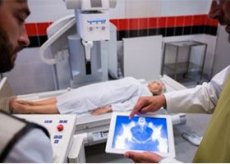Medical expert of the article
New publications
Spinal amyotrophies: causes, symptoms, diagnosis, treatment
Last reviewed: 05.07.2025

All iLive content is medically reviewed or fact checked to ensure as much factual accuracy as possible.
We have strict sourcing guidelines and only link to reputable media sites, academic research institutions and, whenever possible, medically peer reviewed studies. Note that the numbers in parentheses ([1], [2], etc.) are clickable links to these studies.
If you feel that any of our content is inaccurate, out-of-date, or otherwise questionable, please select it and press Ctrl + Enter.

Spinal muscular atrophies are a group of inherited neurological disorders characterized by skeletal muscle damage due to progressive degeneration of neurons in the anterior horns of the spinal cord and motor nuclei of the brainstem. Symptoms may begin in infancy or childhood. They vary depending on the type and may include hypotonia; hypoflexion; impaired sucking, swallowing, and breathing; and, in severe cases, early death. Diagnosis is based on genetic testing. Treatment of spinal muscular atrophies is symptomatic.
Symptoms of spinal muscular atrophy
Spinal muscular atrophy type I (Werdnig-Hoffmann disease) manifests itself at about 6 months of age. There is muscular hypotonia (often noticeable at birth), hyporeflexia, fasciculations of the tongue, and severe difficulties with sucking, swallowing, and breathing. Death occurs from respiratory arrest in the first year of life in 95% of cases, all dying by age 4.
Spinal amyotrophy type II (intermediate). Symptoms usually appear at 3-15 months of age. Children can neither walk nor crawl, less than 25% are able to sit. Flaccid paralysis and fasciculations develop, which are difficult to detect in young children. Deep tendon reflexes are absent, dysphagia is possible. The disease often leads to death at an early age from respiratory complications. However, the progression of the disease can suddenly stop, but persistent weakness and a high risk of severe scoliosis and its complications remain.
Spinal muscular atrophy type III (Kugelberg-Welander disease) usually presents between 15 months and 19 years of age. Features are similar to type I, but the disease progresses more slowly and life expectancy is longer (sometimes normal). Some familial cases are secondary to enzyme defects (eg, hexosaminidase deficiency). Symmetrical weakness and wasting, beginning in the quadriceps and flexors, gradually spreading distally, becoming most pronounced in the shins. The arms are later affected. Life expectancy depends on the development of respiratory complications.
Spinal amyotrophy type IV can be inherited in a recessive, dominant, or X-linked manner, and begins in adults (30–60 years) with primary weakness and wasting of proximal muscles and progresses slowly. This disease is difficult to distinguish from amyotrophic lateral sclerosis, which primarily affects the lower motor neurons.
Diagnosis of spinal amyotrophies
EMG with nerve conduction velocity measurements, including studies of the muscles innervated by the cranial nerves, is required. Conduction velocities are normal, but the affected muscles, often not clinically obvious, behave as if denervated. Definitive diagnosis is made by genetic testing, which identifies the causative mutation in 95% of cases. Muscle biopsy is sometimes performed. Serum enzymes (eg, creatine kinase, aldolase) may be mildly elevated. Amniocentesis is diagnostic.
Treatment of spinal amyotrophies
There is no specific treatment. When the disease stops progressing or develops slowly, physical therapy, a corset, and special devices help (in terms of preventing the development of scoliosis and contractures). Adaptive orthopedic devices open up opportunities for independence and self-care when eating, writing, or working on a computer.


 [
[